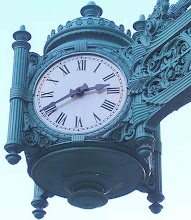
(From the store's 1946 guideboook). Clearly, the goal was to alleviate the feeling that you're in a large impersonal mega-store and make you feel more like you're in a small specialized boutique store. Sometimes they even had their own front door:
 (Also from the 1946 book.) Notice how the architecture -- the curved bay window with small panes of glass, the pedimented doorway, even the glimpse inside at what looks like a living room with upholstered chair, couch and lamp -- all makes it look as if you're entering the home of a classy, elegant but not ostentatious friend who will guide you through your own classy, elegant, but not ostentatious wedding.
(Also from the 1946 book.) Notice how the architecture -- the curved bay window with small panes of glass, the pedimented doorway, even the glimpse inside at what looks like a living room with upholstered chair, couch and lamp -- all makes it look as if you're entering the home of a classy, elegant but not ostentatious friend who will guide you through your own classy, elegant, but not ostentatious wedding.The "shop" architecture could even be a way to signal whether the fashion within suits your style or not, as in this 1970s ad which practically screams "trendy, fashion-forward, not suitable for women who fear pants, enormous fur hats, and maxi dress. Coats with huge fur collars within!"
What's most intriguing is that when department stores moved into suburban malls, they tried to keep the "shops-within-a-store" concept, but seem to have become overwhelmed in a "shops-within-a-mall" environment. Soon the small, specialized boutiques that surrounded the big department stores became more the destination than the big stores.





No comments:
Post a Comment